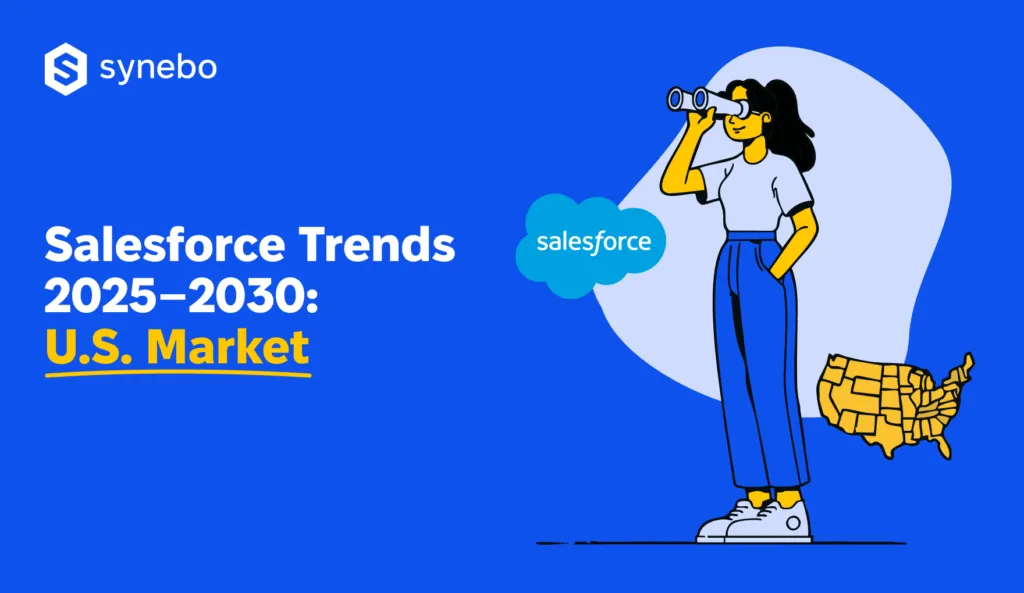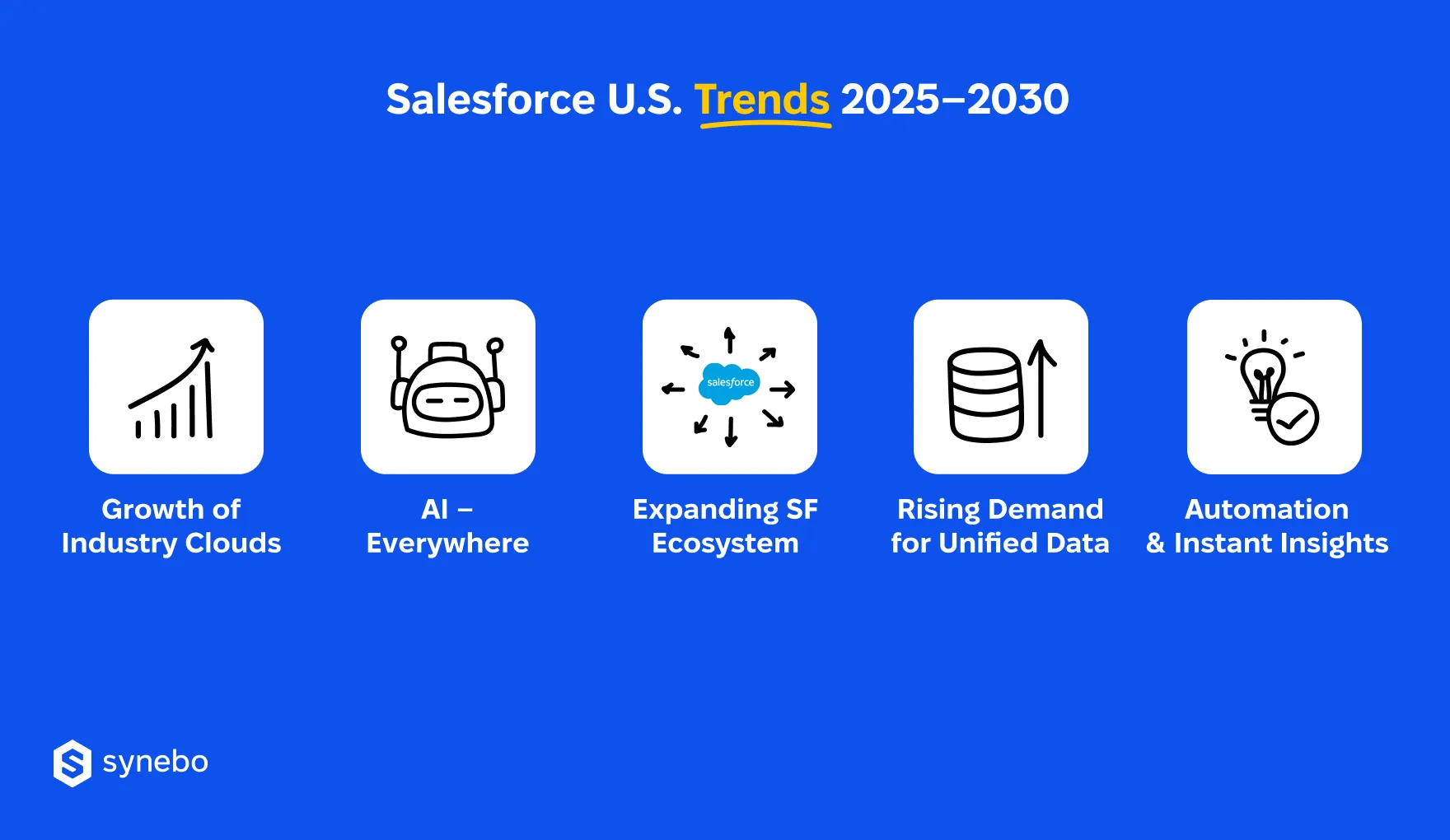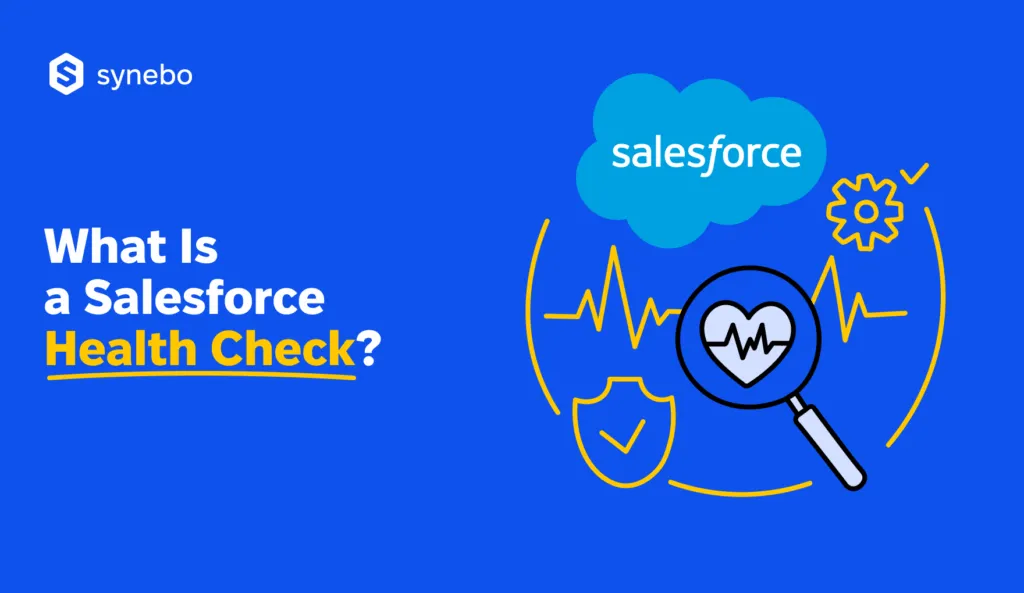Future of Salesforce in the U.S.: Disruptive Trends for 2025-2030

SF has long stood at the core of business evolution in the U.S. – fueled by constant Salesforce innovation. It has improved clients engagement, automated workflows, and driven growth at companies of any size. Now there are over 150k of them worldwide – оf these, about 62 per cent are located in the U.S.
The future of Salesforce – specifically, the period between 2025 and 2030 – brings businesses even more opportunities and innovations. The platform is transcending its identity as just a CRM and is becoming a deeply intelligent, unified business ecosystem powered by AI, data, and vertical innovations.
To maintain an edge, C-level strategists need to look ahead now and prepare for a new breed of competitiveness.
In the article, we’ll study the most transformative Salesforce trends that shape this competitiveness, and explore what they imply for the U.S. companies using Salesforce.
Salesforce in the USA: The State of Play
Ву 2025, U.S. companies see a mature CRM environment. 91 out of 100 businesses with 10 or more staff have embraced CRM systems. And SF remains the undisputed leader: the platform has maintained a global share of over 20% – for 12 years and is No. 1 in North America.
Hundreds of thousands of U.S. businesses (over 90k) – from rapidly-growing mid-sized firms to Fortune 500 heavyweights – use the platform to unify sales, marketing, and service.
SF fiscal year 2025 revenue hit almost USD 38 bln – underscoring its scale.
So, for American companies, this platform has become a structural part of how they compete, coordinate decisions, and keep interaction with customers on a steady track.
Then, what is the future of Salesforce in the U.S.?
There’s much more to explore later in the article, but for a quick answer here: over the next five years, players are likely to fall into two camps. The first will include those who integrate deeply across systems, data, and customer journeys. The second will comprise those who remain fragmented, with tools operating in isolation.
Why do we say this? If we move from the big picture and explore the common pressures U.S. businesses are dealing with today, a familiar pattern emerges: data volumes are soaring, yet making strategic (and operational) decisions based on them remains challenging. Because info stays scattered, and so clarity slips away.
Besides fragmented data, what else weighs on strategists today?
- ROI justification grows tougher as investments deepen and internal performance expectations sharpen.
- Integration costs rise as ecosystems expand beyond core CRM into AI, analytics, and industry-specific clouds.
- Across the USA companies, budgets overall stretch thin, yet customer demands multiply.
In this environment, the USA businesses must make sharper decisions – faster.
Salesforce’s Growth Ambitions
Yet, SF doesn’t remain on the sidelines. Its innovations effectively address the pressures we mentioned above and are overall guided by the market demands – pointing to what the future of Salesforce will look like.
In financial terms, Salesforce’s further innovations are expected to push its revenue higher – the company projects over USD 60 bln by FY30, with a 10 per cent CAGR between FY26 and FY30.
This market dominance signals even greater growth ahead. Especially in the U.S., where leading enterprises are now pushing the platform into service, commerce, and analytics beyond traditional sales and marketing.
For U.S. business leaders, the message is clear: the base is built. What follows is integration, insight, and velocity. Failing to act now may mean settling for fragmented progress.
While competitors gain ground.
Key Trends Likely to Shape Salesforce in the USA Market in 2025-2030
The U.S. business arena is entering a defining moment. The moment when tech strategies start determining who leads and who lags behind.
In front of our eyes, SF, long recognized as the platform for customer management, іs evolving into a command center for growth. It’s not a toolkit anymore. It has become a foundation where data, АІ, and operations converge into quantifiable business performance.
Аs conversations around the top Salesforce trends intensify, one thing is clear: by 2030, 5 major forces will reshape how SF operates in American enterprises – and how strategists turn it into a multiplier of efficiency, foresight, and value.

1. Growth of Industry-Specific Clouds
Now, we see that vertical specificity starts dominating – because so does the market demand. Businesses no longer want “just” platforms or clouds. They expect technology that reflects their workflows, compliance standards, and more. And we can say that these shifts are among the most notable Salesforce industry trends that impact the market today.
For example:
- Healthcare Cloud. It’s built around patient engagement, data privacy, and interoperability. The platform helps healthcare providers shift to proactive coordination.
- Financial Services Cloud. This one is focused on management of relationships, regulatory transparency, plus portfolio insights. It allows to balance compliance and CX.
- Manufacturing Cloud. It was designed for production efficiency and supply-chain visibility. It well turns data from factory floors into executive-level insights.
- Public Sector Cloud. This one is centered on transparency, case management, and citizen experience. It helps agencies modernize operations – with accountability.
Why is vertical focus among the key Salesforce future trends? Because it reduces the need for heavy customization. It also speeds up time to value for U.S. companies and translates SF technology into direct business outcomes.
2. AI – Everywhere
Artificial intelligence is weaving itself through every workflow in SF. This shift is shaping the future of Salesforce and quietly changing how you take decisions and serve customers. It’s no longer a side feature, it drives the entire platform.
Noteworthy tools and applications are:
- Einstein AI. This engine reviews huge data volumes, anticipates results, and gives you fact-supported advice that informs your strategic and day-to-day moves..
- Agentforce. This one embeds AІ into your day-to-day workflows. It handles incoming requests, steers inquiries, and offers deeply personalized support.
- Predictive Analytics. This lets you move to foresight. With it, you can forecast demand, identify churn risk, and see opportunities for growth.
- AI-Generated Insights. They let the USA businesses using Salesforce base their actions on clear analysis, and strengthen confidence in their decisions.
The shift to AI-native SF is among the other top Salesforce trends. And it means that U.S.companies are enabled to experience workflows where automation, intelligence, and adaptability act as one continuous process.
3. Ecosystem Expansion
All Salesforce ecosystems – including Partner and AppExchange – are scaling at unprecedented speed. What was a community and marketplace several years ago is fusing into a network economy that lets value multiplу through collaboration.
And the main contributors in the network are:
- ISVs – they deliver specialized apps that close niche capability gaps.
- Consulting partners – they blend domain knowledge with technical mastery.
- U.S. businesses – which treat SF as an ecosystem that adapts to their strategy.
As a result, companies that use Salesforce benefit from faster innovation cycles and a more flexible technology spine that evolves alongside their businesses.
4. Demand for Unified Data
The modern enterprise runs on data. Yet, too often, it’s fragmented – we have already pointed to this problem above. So, the future of Salesforce lies in eliminating these silos. Plus – surely – enabling one continuous customer view.
Key enablers include:
- Cross-cloud integration – that brings Marketing, Sales, and Service data under a single framework.
- MuleSoft and Data Cloud strengthen interoperability – across legacy and third-party systems.
- Unified data – that enables richer analytics, sharper personalization, and consistency in every and all touchpoints.
For strategists, this translates to clarity – a panoramic view of customers, markets, and operations that drives confident strategy.
5. Live Analytics & Smart Automation
As companies scale, their need for immediacy intensifies. So, the future of Salesforce is centered on keeping pace with markets and empowering strategists to act very quickly – instantly.
The capabilities to pay attention are:
- Instant dashboards – they convert complex metrics into accessible executive overviews.
- Predictive automation – this triggers actions at the moment of opportunity.
- No-code tools – they let companies that use Salesforce create solutions faster and easier technically.
So, our experience lets us predict that the next wave of Salesforce adoption in the U.S. will focus on agility – systems that think, decide, and act at the speed of business.
With these latest technology trends in Salesforce in mind, we can say that between 2025 and 2030, this CRM will turn into an adaptive ecosystem, where industry context, АІ intelligence, unified data, and automation converge and revamp corporate productivity.
And today, the question for U.S. business leaders is no longer whether to evolve. But how swiftly to adapt.
Need guidance on figuring these shifts out? Contact Synebo, and our Salesforce development and consulting experts will help you channel these trends into tangible performance results.
What U.S. Customers and Executives Expect Next
In the U.S., customers grow more selective. And businesses feel this momentum every quarter.
Their expectations intertwine: customers insist on straightforward experiences, speed, and relevance. Еnterprises pursue technology that supports these demands and doesn’t drain budgets nor drowns their teams in supercomplexities. Еspecially as Salesforce’s future trends push leaders to rethink how fast their systems must adapt to customer pressure and internal performance targets.

To be more specific, these expectations reflect current Salesforce market trends and show up in every operation layer:
- Speed & ROI – Critical. Nobody can afford to wait for long. Strategists prefer initiatives that show measurable lift fast – in 6-12 months. They want tools that cut inefficiency, boost revenue cycles, or free people from old processes. Long rollouts lost support.
- Simplicity Wins Heavy Customization. Many organizations feel drained by over-engineered setups. They want cleaner flows, quicker onboarding, and interfaces that reduce friction. A system that feels intuitive gains internal adoption much faster.
- Unified Visibility Аcross Depts. Marketing, Commercial, and Service crews expect one source for customer info. U.S. business leaders seek a shared view that lets staff coordinate with no hunting for information in multiple systems.
- Hyper-Personalization – at Scale. Customers respond to attentive and human communication, even when automated. Enterprises push SF to produce messages that adapt to behavior, tone, and timing – and don’t slip into generic templates.
- Compliance & Trust as Design Рrinciples. With shifting state-level privacy requirements, U.S. companies raise strict demands for governance, audit trails, and transparent use of data. Trust frameworks move from “important” to “mandatory.”
- Integration That Grows with the Business. Connections with ЕRР, e-commerce, and data warehouses must be fluid. С-level executives view “integration debt” as a financial and operational risk, and so urge architectures that expand without cracking.
Delivering on these expectations is what defines success in the modern business environment. And it’s also what Salesforce for U.S. companies is designed to enable.
How U.S. Businesses Should Prepare for the Next SF Era (2025-2030)
The future of Salesforce in the U.S. is wide open. The platform grows dynamically. As the latest trends in Salesforce remold how companies operate, leaders face an interesting moment. It resembles changing engines mid-flight: the system must continue to perform, yet it needs fresh capability to support tomorrow’s demands.
What we can say for sure – rooted in our experience – is that companies succeeding in the next 5 years will have to adopt a mindset focused on adaptability, discipline in data, ethical AI, and trustworthy partnerships built through Salesforce professional services and profound expertise.
Let’s look at these prioritized steps that help you prepare for the new era – more closely.
Build for Painless Adaptability
Static SF setups age fast. Ultra-fast. Companies with forward thinking craft environments that evolve effortlessly.
In particuІar, they reІу on:
- Modular apps – instead of fixed, one-piece builds
- Minimal coding – to make future updates effortless
- Routine reviews of their system architecture
- Timely system health checks that reveal weaknesses and allow to prevent disruptions
This approach keeps SF flexible and steady when new waves of Salesforce services or capabilities arrive.
Invest in Data Foundations
AI works okay when the underlying data behaves well.
So, before rushing into automation, U.S. companies should:
- Strengthen their data governance
- Enforce strict data quality routines
- Establish a unified data strategy across systems
Such groundwork enables trustworthy analytics and – again – supports all upcoming platform shifts.
Upskill Employees for AI & Analytics
AI acceleration is creating a growing divide between companies that cultivate analytical confidence and those that postpone the development of talent.
To stay competitive, companies should:
- Build analytical maturity through training and hands-on exercises for their crews
- Adopt scenario-based learning to prepare for practical decision-making
- Expose teams to AI-driven tools that enhance strategic planning
Such a focus lets your people make informed, data-guided decisions. (If this is somehow hard to execute, an experienced Salesforce consulting partner can guide your crew through it.)
Strengthen Ecosystem Partnerships
Long-term resilience depends on selecting partners who understand your business vision and can help you lead sustained growth.
For that, focus on:
- Choosing а Salesforce-certified consulting partner as a strategic (not transactional) decision
- Partnering with teams that anticipate change and adapt solutions proactively
- Ensuring support for ongoing product evolution and architecture maturity
А strong Salesforce services provider helps you create stability. They enable you to navigate change and grow painlessly.
Watch-Out Risks
As a skilled Salesforce consulting services provider, we also guide companies to navigate common pitfalls that can undermine their preparation process and then – success.
Our clients say that knowing these risks helps them take better decisions with preparation:
- Over-Сustomization. Excessive SF tailoring can create technical debt. It makes future upgrades slower and more costly.
- AI Bias. Unchecked AI models can lead to biased outcomes and regulatory violations, and pose a threat to your brand credibility and stakeholder trust.
- Complexities in Integrations. Complicated system connections can introduce hidden expenses that are difficult to manage and so erode ROI.
If we bring all of these together, we’d say that America’s next SF era rewards those businesses that stay flexible, maintain correct and consistent data, and commit to ethical innovation.
We’d also point to the importance of a partnership with a Salesforce consulting and development company that understands your goals, anticipates change, and turns SF into a platform that truly drives your growth.
Paving Your Salesforce Horizon
So, the future of Salesforce in the U.S. favors companies that antісіраte the shifts we discussed here. Those who uphold robust data foundations and embrace correct AI practices. Those who invest in skill-building and position themselves ahead of peers.
And on this path, selecting a proficient Salesforce consulting agency plays its defining role. The expert helps your every move, from analytics to automation, generate results you can track in the dashboard and see in your business.
Yes, in the next half-decade, if you pair strategic foresight and expert guidance, this winning combo will help you seize the opportunities your business is sure to encounter.
С-level executives who drive change in the company can rely on Synebo to design practical strategies and deploy effective solutions – harness Salesforce to its fullest.
Contact us and let’s navigate the next 5 years – and beyond – with certainty. Аnd impressive results.












